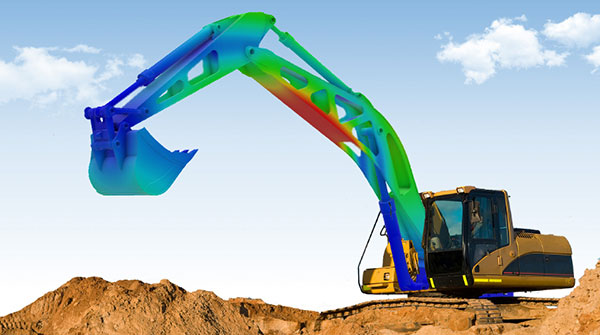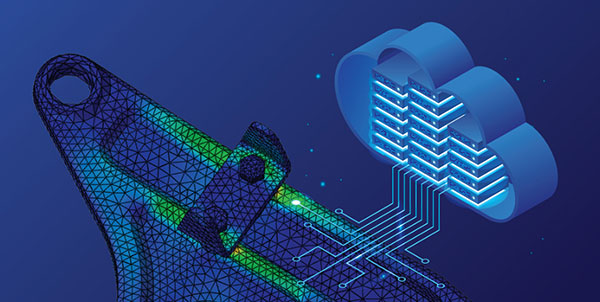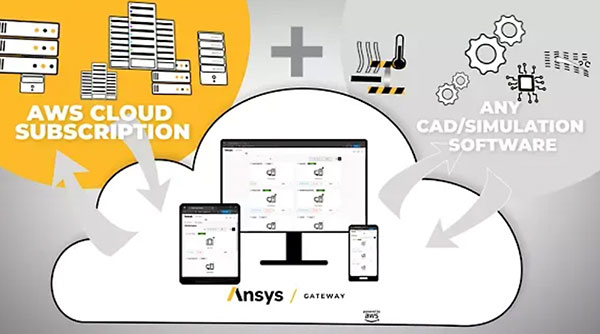Fine-Tuning the Hybrid Workforce
How to find the computational balance in a work-from-anywhere strategy.

SolidWorks Simulation can be used on a local computer or from a cloud-based platform. Image courtesy of Dassault Systèmes.
Engineering Computing News
Engineering Computing Resources


Dassault Systemes

Latest News
April 14, 2023
With the pandemic reaching new stages, many engineering teams are creating a work-from-anywhere strategy without compromising productivity. Some companies are mandating a return to the office, others are taking a more flexible approach, with engineers working from home part of the time, in the office, or even from customer sites or on the road.
This hybrid approach to work requires a mix of high-performance workstations, cloud-based applications or resources, and data center or server-based solutions to ensure that engineering productivity is not compromised. Companies can enable a work-from-anywhere strategy without compromising engineering productivity, but the question is how?
Which workflows can benefit from a hybrid approach? Which simulation workloads are best suited for workstations or cloud-based resources?
Strategizing Work From Anywhere
The first step in creating a work-from-anywhere strategy is to ensure engineers have access to the tools and resources they need, regardless of location. This requires a mix of hardware and software solutions supporting compute-intensive workflows and collaborative design processes.
The cloud providers serving engineering, including Amazon Web Services (AWS), Microsoft, Google and IBM, are now providing scalable computing services to engineering organizations worldwide. It has allowed the rise of digital twins and better manufacturing process monitoring.
“Cloud computing enables engineers to access the resources they need on-demand, reducing the time and cost associated with managing on-premises infrastructure,” says Prith Banerjee, chief technology officer at Ansys. The company partners with AWS to provide access to scalable, high-performance computing (HPC) resources.
Though cloud-based solutions offer many benefits, these solutions may not be the best fit for all engineering workflows. For example, some simulation workloads require high-performance workstations with powerful graphics processing units (GPUs) to deliver the performance engineers need to complete their simulations quickly. For these workflows, workstations with up to 56 processing cores and support for up to three NVIDIA Quadro RTX GPUs may be the best option.

The full line of Dassault Systèmes engineering simulation software is fully cloud-enabled. Image courtesy of Inceptra.
Hybrid Workflows
A hybrid hardware approach, which combines the use of workstations and cloud-based resources, can be beneficial for engineering design and simulation workflows that require large-scale computational power, extensive data storage and complex analysis. These compute-intensive applications include:
Finite element analysis (FEA) simulations that can require a significant amount of computing resources, particularly for large and complex models.
Computational fluid dynamics (CFD) simulations that also can be resource-intensive, especially for high-resolution models and simulations with a large number of iterations.
Multiphysics simulations that involve the interaction between multiple physical phenomena, which can be compute-intensive and benefit from a hybrid approach.
Monte Carlo simulations that require a large number of iterations, which can be compute-intensive and benefit from the additional resources of a hybrid approach.
Large-scale engineering models, such as those used in civil or transportation manufacturing, that also can benefit from a hybrid approach, as they can require a significant amount of computing resources.
“Hybrid workflows can benefit from collaboration and real-time feedback,” says Matt Commens, principal product manager, Ansys. “In these cases, engineers can run simulations on high-performance workstations or data center-based solutions when they are in the office, and then switch to cloud-based resources when they are working remotely to enable real-time collaboration and feedback.”

Generally, workstations are best suited for simulations that require less computational power, such as simple structural analysis or 2D simulations. On the other hand, HPC clusters and/or cloud-based resources are better suited for simulations that require extensive computational power and memory, such as large-scale FEA and CFD simulations. Cloud-based resources are also useful for engineering workflows that require collaboration between team members, as they provide a centralized data storage and analysis platform.
Simulating the Wind in 12 Minutes
Accelerate Wind is a manufacturing startup that specializes in affordable wind turbines for commercial buildings. Its on-premises computer resources were becoming a bottleneck for the complex CFD requirements. They didn’t know if the answer was to buy more in-house resources or move it to the cloud.

Accelerate Wind uses cloud resources from AWS to run complex simulations on new wind generators for commercial buildings. Image courtesy of AMD.
“TotalCAE helped us migrate and do some benchmark testing,” says Adam Bennett, an engineer at Accelerate Wind. “We ran a few different types of simulations, 2D, 3D, with different sizes, different core numbers. Our 384-core Amazon EC2 Hpc6a instance powered by an AMD EPYC processor was 15 times faster than the 32-core on-premises system, with just 12 times more cores, taking a 4-hour simulation on the workstation down to 12 minutes.”
Having this kind of performance on tap when required has been a huge advantage. “Our computational needs vary from time to time,” says Bennett. “Our projects are constantly changing. One day we might have very low computational needs and another, we’re running large models.”
“We often need to run a whole bunch of iterations of different simulations really quickly,” says Erika Boeing, Accelerate Wind CEO. “It wouldn’t make any sense to buy a 384-core system to keep on premises for the months or weeks of iterations we need, unused the rest of the time. But having the Hpc6a instance when we need it lets us get answers quickly. We have been able to run through hundreds of different simulations in a week, whereas before, that would have been a multiple-month process.”
How to Pick a Cloud Provider
The best cloud services provider for running engineering simulation software will depend on the specific requirements and needs of each engineering organization. Among the top five cloud services providers, AWS, Microsoft Azure and Google Cloud Platform (GCP) are generally considered to be well suited for running engineering simulation software:
AWS: AWS offers a wide range of cloud-based resources, including HPC instances and GPU-based instances.
Microsoft Azure: Azure offers various services, including HPC virtual machines that are suitable for running engineering simulations. It also offers support for popular simulation software packages.
Google Cloud Platform (GCP): GCP offers a range of cloud-based resources, including GPU-based virtual machines, making it a good fit for running GPU-accelerated engineering simulations.
It is recommended that engineering organizations carefully evaluate the specific needs and requirements of their simulation workloads, as well as the offerings of each cloud provider, to determine the best fit for their needs. A hybrid approach that combines the use of local workstations and cloud-based resources also can be beneficial in many cases and provide the best of both worlds.
A Work-From-Anywhere Strategy
Engineering groups and companies can enable a work-anywhere strategy without compromising engineering integrity by implementing the following steps:
- Cloud-based infrastructure: By moving compute-intensive simulations and design workflows to cloud-based infrastructure, engineering teams can access the resources they need from anywhere.
- Secure remote access: Implementing secure remote access protocols, such as VPN, ensures that engineers can access the data and systems they need securely.
- Data management and backup: Proper data management and backup strategies ensure that engineering data is secure and accessible from anywhere.
- Collaboration tools: Using collaboration tools, such as web conferencing and document sharing platforms, enables engineers to work together effectively regardless of location.
- Performance monitoring: Regularly monitoring performance of remote workstations and cloud resources helps ensure that engineers have the resources they need to do their jobs effectively.
More Ansys Coverage
More Dassault Systemes Coverage

Subscribe to our FREE magazine, FREE email newsletters or both!
Latest News
About the Author
Randall S. Newton is principal analyst at Consilia Vektor, covering engineering technology. He has been part of the computer graphics industry in a variety of roles since 1985.
Follow DE



